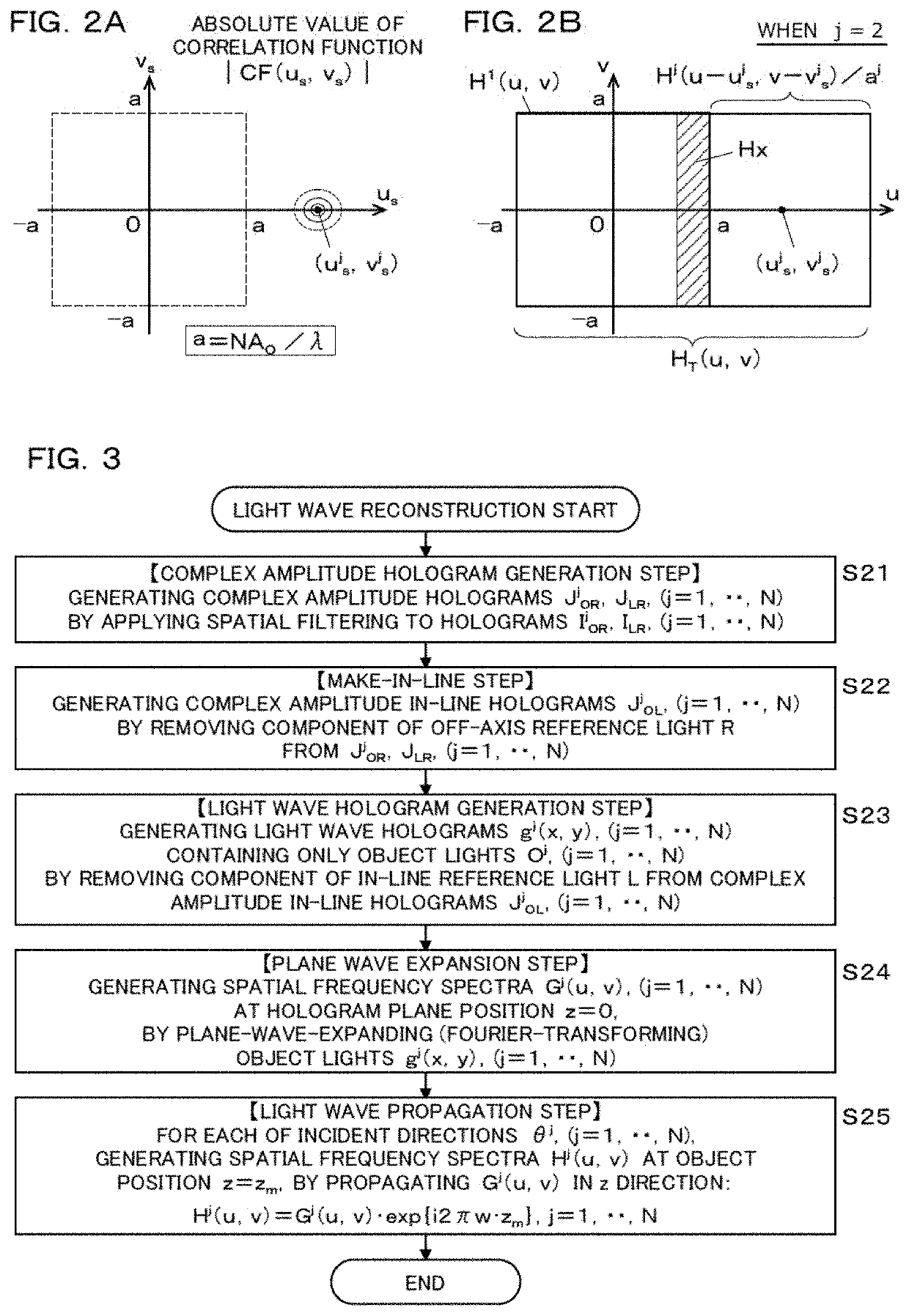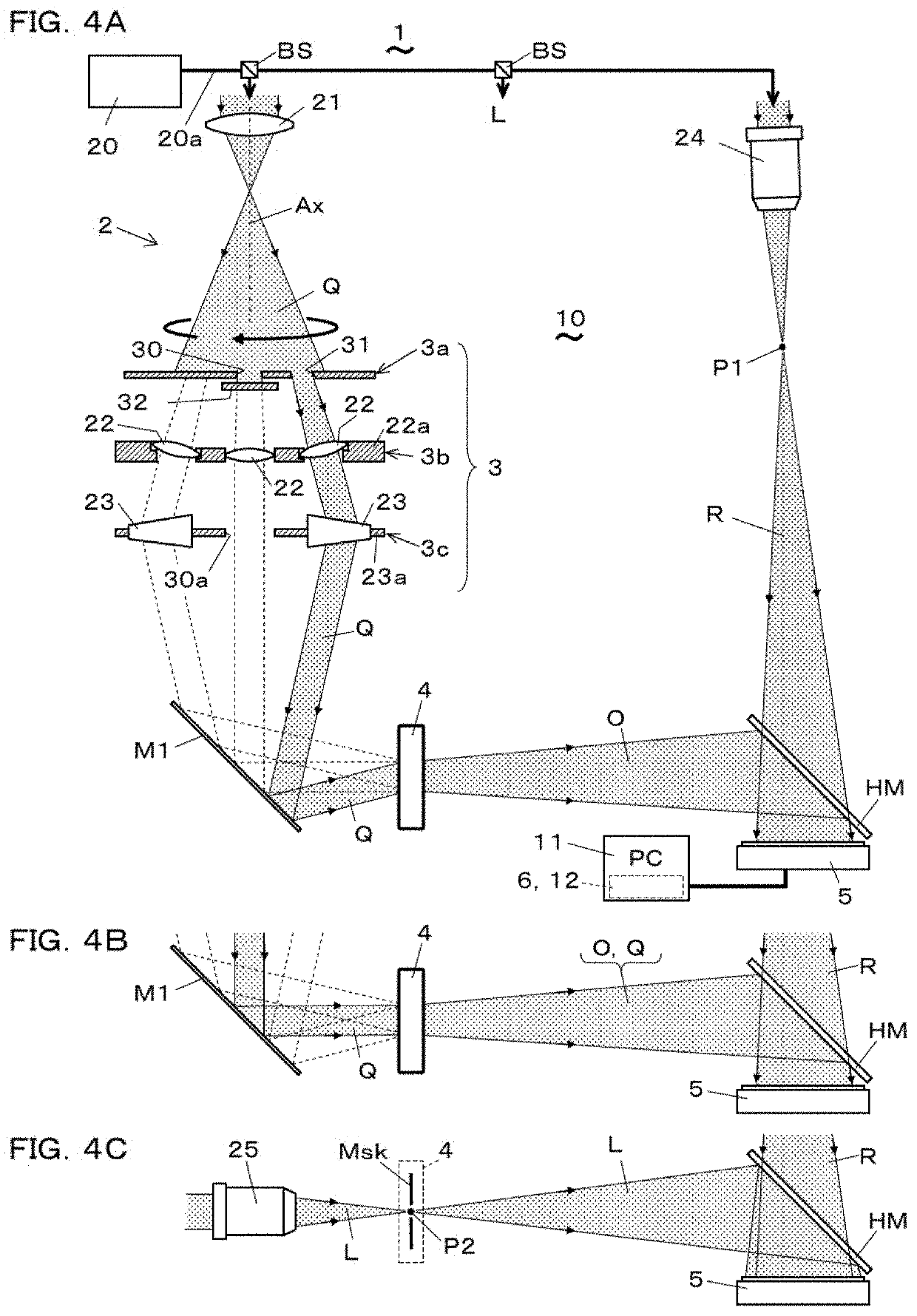Holographic Imaging Device and Data Processing Method Therefor
a holographic imaging and data processing technology, applied in the field of digital holography, can solve the problems of not exceeding the half wavelength of light, difficult to improve performance and function, and difficult to improve resolution, and achieve the effects of simple structure, simple structure and easy handling
- Summary
- Abstract
- Description
- Claims
- Application Information
AI Technical Summary
Benefits of technology
Problems solved by technology
Method used
Image
Examples
1st embodiment
The Data Processing Method
[0078]FIG. 1 to FIG. 3 show the data processing method according to the 1st embodiment. As shown in FIG. 1, this data processing method comprises a data acquisition step (S1), a light wave reconstruction step (S2), an initialization step (S3), three steps in an incident direction loop LPs and LPe, namely, a mutual cross correlation step (S4), a fitting coefficient derivation step (S5), a synthesis step (S6), and a step after the loop, namely, a synthetic light wave generation step (S7).
[0079]The present data processing method performs synthesis of hologram data using a principle that: when an object is illuminated with an obliquely incident parallel illumination light Q and an object light O emitted from the object is recorded as an object light off-axis hologram IOR using a reference light R, a spatial frequency spectrum H(u, v) of the object light O derived from the hologram IOR shifts in a spatial frequency space (u, v) according to an incident angle θ ...
tenth embodiment
[0180]With reference to FIG. 22 to FIG. 24, the light wave hologram g and the spatial sampling interval δ are described. Each of the holographic imaging devices described above records the object light O by using the spherical wave reference light R having the focal point P1 at a position close to the generation point of the object light O spreading like a spherical wave. Therefore, the spatial frequency band of the hologram of the interference fringes of the object light O and the reference light R is narrowed. From such a hologram, if a hologram with only the object light O alone is taken out, the spatial frequency band becomes broader to high frequency. From this, it can be seen that the light wave hologram g(x, y) of above equation (10) expressing the wavefront of the object light O has a broader space frequency band than the complex amplitude in-line hologram JOL(X, y) of above equation (9).
[0181]The spatial variation of the light wave hologram g(x, y) becomes larger as going a...
example 1
tion of Long Working Distance, Wide Field of View, Transmission Type Imaging Device
[0206]Using the holographic imaging device, which has the angle change unit 3 shown in the 6th embodiment (FIG. 11), imaging tests were performed with a USAF test target as a subject (object 4). A green excitation solid-state laser (wavelength: 532 nm, output: 50 mW) was used as a light source, and an off-axis spherical wave reference light R was generated using an objective lens with a numerical aperture of 0.28. A monochrome camera link CCD camera was used as the photo-detector 5. The distance from the CCD to the target, the numerical aperture, and the recordable field size W are, respectively, zm=52.4 cm, NAO=0.019, and W=25 mm. The theoretical resolution is 14.0 μm, which is determined from the numerical aperture NAO=0.019.
[0207]The configuration of the optical system of a holographic imaging device having a numerical aperture NAO=0.019 can be regarded as a configuration in which the numerical ape...
PUM
 Login to View More
Login to View More Abstract
Description
Claims
Application Information
 Login to View More
Login to View More - R&D
- Intellectual Property
- Life Sciences
- Materials
- Tech Scout
- Unparalleled Data Quality
- Higher Quality Content
- 60% Fewer Hallucinations
Browse by: Latest US Patents, China's latest patents, Technical Efficacy Thesaurus, Application Domain, Technology Topic, Popular Technical Reports.
© 2025 PatSnap. All rights reserved.Legal|Privacy policy|Modern Slavery Act Transparency Statement|Sitemap|About US| Contact US: help@patsnap.com



